As hair
accessories take centre stage for autumn, Io Ellison sings a hymn for the
humble bobby pin
This is how a woman marks her territory.”
So announced an email forwarded by a colleague last week. Attached was a photo
of three lonely kirby grips discarded on a desk top - as clear a sign as any
that one has entered a girl’s world.
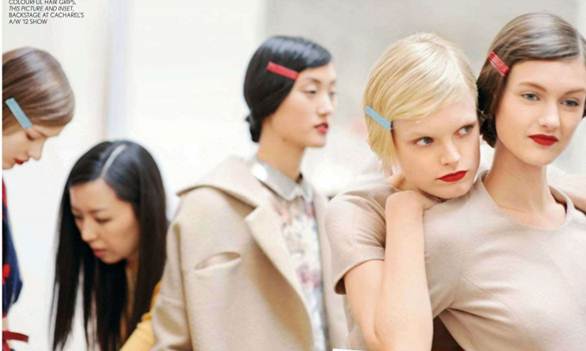
Colorful
hair grips, this picture and inset, backstage at cacharel’s a/w ’12 show
Call me overcautious, but beside my
computer you will always find an enormous pack of grips, poised to pin up hair
deflation at a moment’s notice. I get them from hairdresser supply stockists,
coiled on gigantic spools or in huge plastic boxes, only for them to diminish,
slowly, pin by pin, as the months turn.
Where they disappear to I never really
know-one friend clips them close. Left alone, that vanish underneath sofas and
scatter from pockets. Sadly neglected, they rust away at the bottom of wash
bags or, worse, expire in the washing machine. At night, discarded grips align
my bedside table - clattering to the floor when I turn out the light.
Hairpins are a follicular safety blanket
(albeit a rather spiky one). No matter how bad the bad the hair day-and,
frankly, I’ve been cursed with far more than is fair-a clutch of grips can put almost
anything right. As hairstylist Sam McKnight says: “They are your insurance
against disast - hair! Fix carefully and you’re free from worry. Your ’do will
not water.”
The unsung pit pony of the beauty world,
the grip works tirelessly on our behalf. In Childhood, they tidy up our fringes
and ponytails. In adulthood, they tidy up our fringes and ponytails. In
adulthood, they facilitate our every whim: underpinning French twists,
chignons, topknots, beehives and buns, they lend us instant sophistication;
clipped on to an errant strand of flowing hair, they give a carefree, bohemian
air; pinned to a side parting, they help us channel the youthful zest of the
Twenties-the ear in which the “bobby pin” was first patented, by the Bob Lépine
Corporation of Buffalo, New York (likewise the Kirbigrip, which was developed
by Kirby, Beard & Co Ltd, a Birmingham manufacturer of all things useful,
little and pointy).
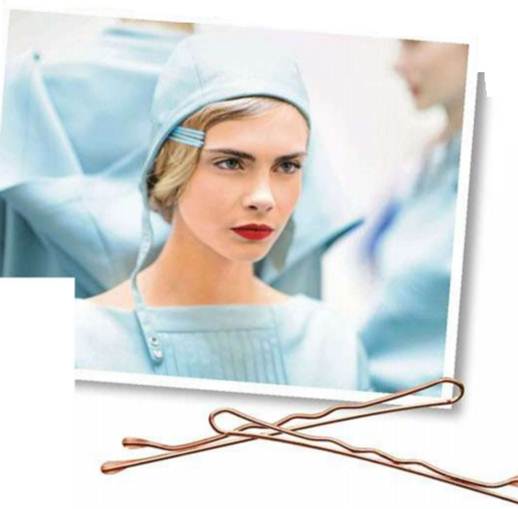
Hairstylist
Sam McKnight likes hair grip to be proudly on show. “A bit like Beaubourg’s
Centre Pompidou, inside out. Very modern”
Their usefulness is borne out in corner
shops and pharmacies the world over; even the dustiest retailer will offer up
some version, spiraled around a fading sheaf of cardboard and sat next to the
travel sewing-kits and erasers. Through designs very. The Japanese, for
example, favor shorter, steel varieties with a lethal snap; the French prefer
the finer, U-shaped pins with tiny rubberized tips that hook around the hair; a
Beirut-born colleague insists on her countrywomen’s dependence on the
mega-sized chignon-pin: “The bigger the better-the Lebanese do like their
volume.” I’m a girl myself, a preference inherited from my 94-year-old
grandmother, who daily fastens her French pleat with four enormous steel grips
that she has retained for decades and which, she always cautions, will “break
your teeth” given half a chance.
McKnight keeps 13 different varieties close
to hand, each a “vital tool” with many uses. “The grips have a better, flatter,
more direct hold-they’re an aggressive, take-no-prisoners, tight, flat
securer,” he explains. “While the pins can firmly secure a looser, more
voluminous ’do. I use both simultaneously: the tiny ones are perfect for
invisibly fastening on wigs and tiny knots and twists, while the larger ones make
a light, airy beehive or baggy chignon easier to achieve. Sometimes one large
pin strategically placed is all that’s required.”
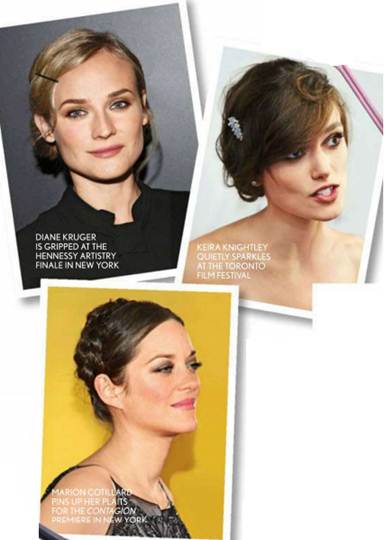
“The
grips have a better, flatter, more direct hold-they’re an aggressive,
take-no-prisoners, tight, flat securer”
Hairstylist Luke Hersheson agrees. “The big
chignon pins were first used in the Fifties to create French pleats, and are
harder to use than the grips-any hairdresser worth his while should be able to
secure a whole ‘’do with a single pin.” (Needless to say, I am no hairdresser-I
reckon I average about 10 pins per try, and even then I like to carry a few for
contingency.)
As to the question of whether the pin
should be seen or not seen, McKnight is a big advocate of exposure. “I like
them to be proudly on show,” he says. “A bit like Beaubourg’s Centre Pompidou,
inside out. Very modern.”
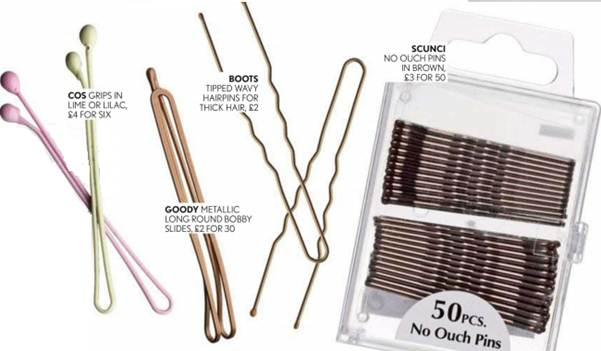
“With
these, you can just pop one in your handbag and you’ll never be without again.”
From delicate pastel to embellished, there
are more grip options available than ever. “I love the matt rubberized ones,”
says McKnight, who designed delicious grips for Chanel last season. On which
were affixed a single pearl. “They’re so secure, they’re almost permanent.
Anything can be stuck on them-flowers ribbons, lace, plastic novelties, Swarovski
crystal. Those huge bows at Chanel were not tied on, no! They were secured by
pins and grips.”
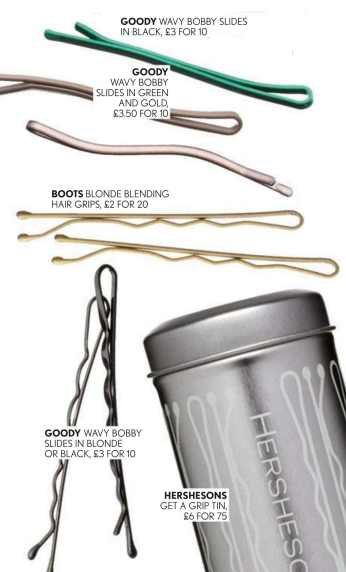
Goody
wavy bobby slides
And despite McKnight advice that I “get a
magnet”, it seems there may be a permanent solution to the lost pin conundrum.
In September, Hershesons is launching its dinky little Get A Grip tins,
containers holding about 75 pins and grips apiece. “I just noticed that on my girlfriends
kept losing them or dropping them all over the place,” says Hersheson of his
latest invention. “With these, you can just pop one in your handbag and you’ll
never be without again.” I’m gripped already.